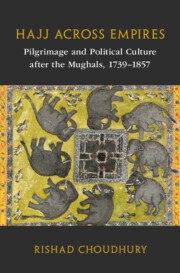Book contents
- Hajj across Empires
- Asian Connections
- Hajj across Empires
- Copyright page
- Dedication
- Epigraph
- Contents
- Figures
- Maps
- Tables
- Preface and Acknowledgments
- Note on Transliterations and Translations
- Abbreviations
- Maps
- Introduction
- Part I Departures
- 1 Pilgrim Passages
- 2 The Hajj Bazaar Economy
- Part II Crossings
- Part III Returns
- Bibliography
- Index
- Asian Connections
1 - Pilgrim Passages
from Part I - Departures
Published online by Cambridge University Press: 01 February 2024
- Hajj across Empires
- Asian Connections
- Hajj across Empires
- Copyright page
- Dedication
- Epigraph
- Contents
- Figures
- Maps
- Tables
- Preface and Acknowledgments
- Note on Transliterations and Translations
- Abbreviations
- Maps
- Introduction
- Part I Departures
- 1 Pilgrim Passages
- 2 The Hajj Bazaar Economy
- Part II Crossings
- Part III Returns
- Bibliography
- Index
- Asian Connections
Summary
The opening chapter builds on a wide-ranging corpus of documents and texts, but at its core is a set of narrative accounts written South Asian hajj pilgrims between 1739 and 1857. Taken together, the sources illuminate how the hajj from India acquired distinctly “imperial” characteristics from the Mughals onward, and how Indian pilgrims hence also took mental stock of the later unraveling of empire through a signal watchword: “revolution” (inqilāb). The chapter begins by showing how Mughal patronage of hajj created ties of loyalty and subordination between the empire and its subjects. Taking readers from the classical Mughal era to the Sepoy Rebellion, it then reveals how – despite successive waves of regime change and revolution in both India and the Islamic world – the expansion of hajj equaled in South Asians experiencing pilgrimage as an interregional and even “global” undertaking, whose articulations, in turn, they recorded through personal narratives of travel firsthand accounts that offered views of mobility from the decks of Indian Ocean ships and from caravan journeys through the Arabian desert. At the broadest level, the chapter ultimately also contributes to recent scholarly efforts to situate the “age of revolutions” in non-European and global contexts.
- Type
- Chapter
- Information
- Hajj across EmpiresPilgrimage and Political Culture after the Mughals, 1739–1857, pp. 25 - 67Publisher: Cambridge University PressPrint publication year: 2024

